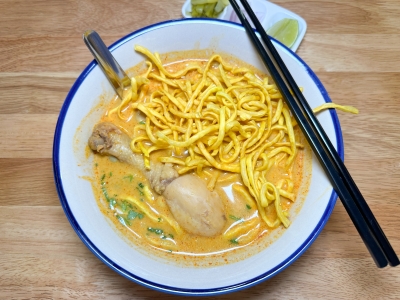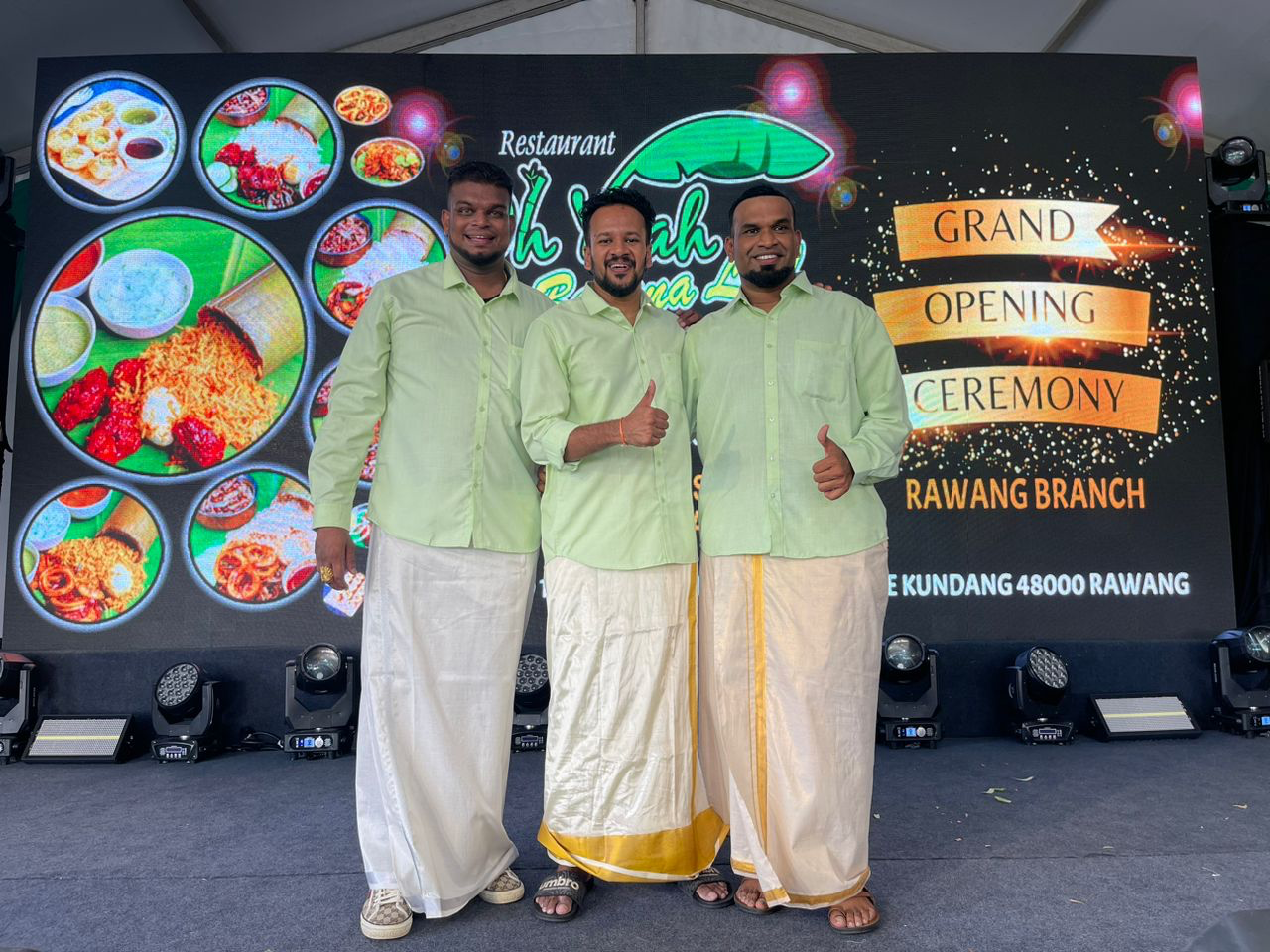PETALING JAYA, March 4 — Driving down the Damansara-Puchong Expressway (LDP) is often a test of one’s patience, especially during peak hours.
When I’m in standstill traffic, my eyes tend to wander a bit. And near the part of the expressway where the shophouses face the Kelana Jaya LRT Station, I spied this crazy name “Sood Yod”.
At first glance, I actually thought it was profanity. Later, I found out it actually means “awesome” in Thai and in this case refers to an eatery showcasing Chiang Mai food.
Curious about the place, I went there one weekend.
Advertisement
With the heatwave we have been experiencing, we appreciated the powerful air-conditioner just across from our table.
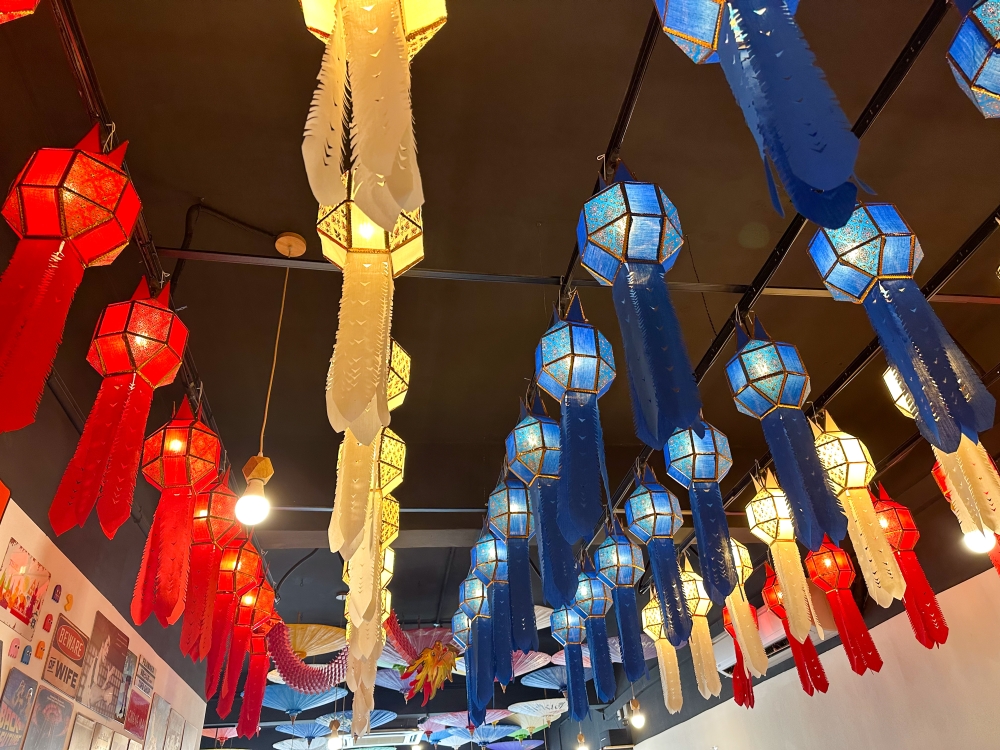
Sood Yod Thai’s eye catching red, blue and white lanterns pay tribute to the Thai flag.
Playful touches to the decor made us go “wow”. Who can resist those multiple lanterns in red, blue and white hues. Keen eyes can spot how that sequence of colours resembles the Thai flag.
Advertisement
You also have two murals, including one that will evoke travel nostalgia with a map showing Chiang Mai’s landmarks. My friend was happily reminiscing her last trip to Chiang Mai, pointing out each landmark on the map.
The food here stays true to the owner’s Northern Thailand upbringing. For instance, the Khanom Jeen Nam Ngiao uses a recipe passed down from her grandmother where the broth uses cherry tomatoes and the flowers of the red cotton tree for a tart and sweet flavour combination. It’s served with minced pork, chicken feet, pork ribs and coagulated blood cubes.
We didn’t get to try it this round but it’s definitely on the list for my next visit. My other friends are already planning a visit soon.
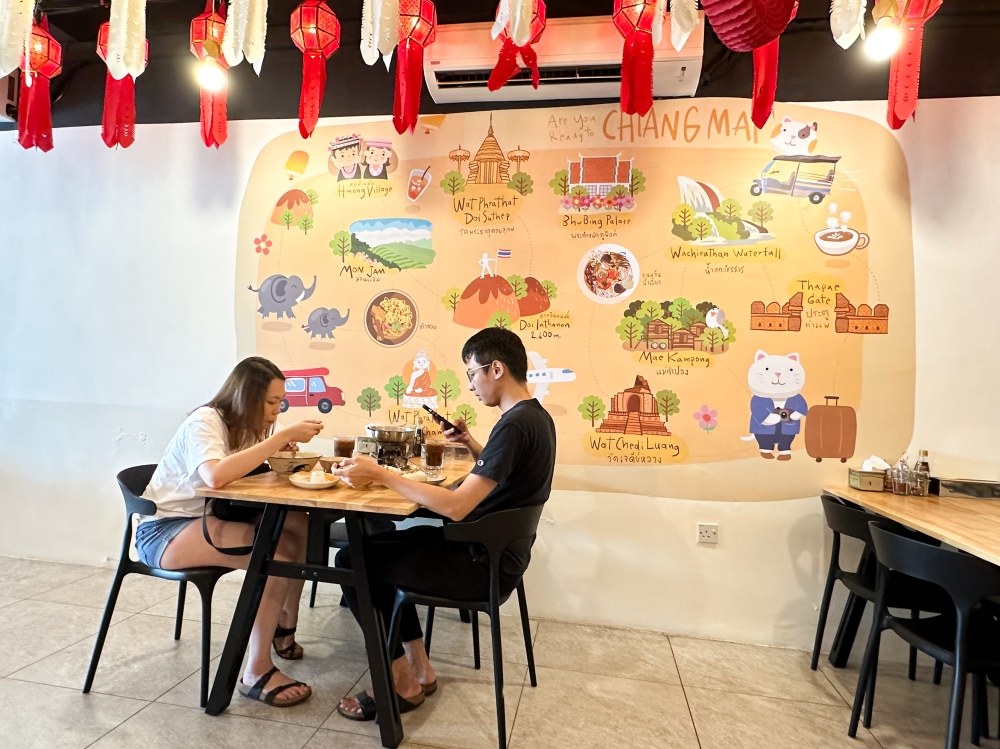
Murals like this one depicting landmarks all around Chiang Mai evokes memories about the place.
Here, the spiciness is dialled back, typical of what’s found in Chiang Mai. Diners who prefer smoking hot heat in their dishes can request more chillies.
The menu covers a wide variety of noodles aside from the signature khao soi and khanom jeen. There’s kway chap, their version of wantan mee, pork noodles served with kuey teow,
The rice selection is compact, with of course the iconic Khao Kha Moo or stewed pork leg. The soft wobbly pork is also paired with egg noodles.
Other rice dishes include those with green curry with chicken or fish and a crispy chicken fillet. You also have their Tom Yam Nam Sai, a clear version served with assorted seafood and the heart of the coconut palm.
Khao Soi Kai (RM16) is the poster child of Chiang Mai cuisine.
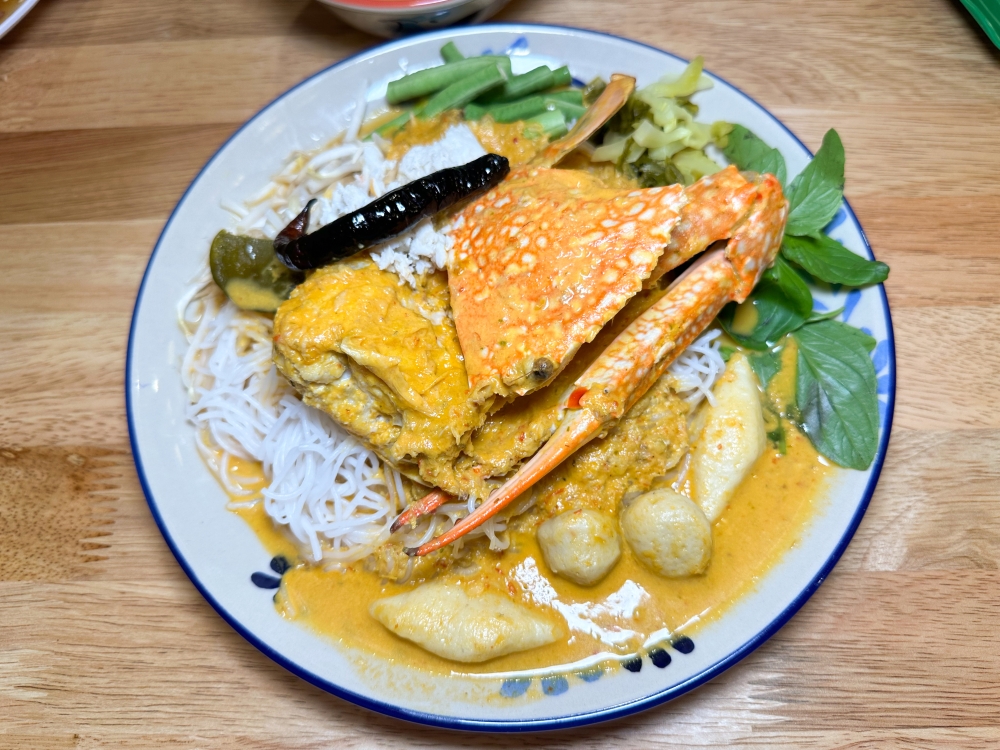
This could be the best Khanom Jeen Nam Ya Pu with that super fresh flower crab with sweet flesh.
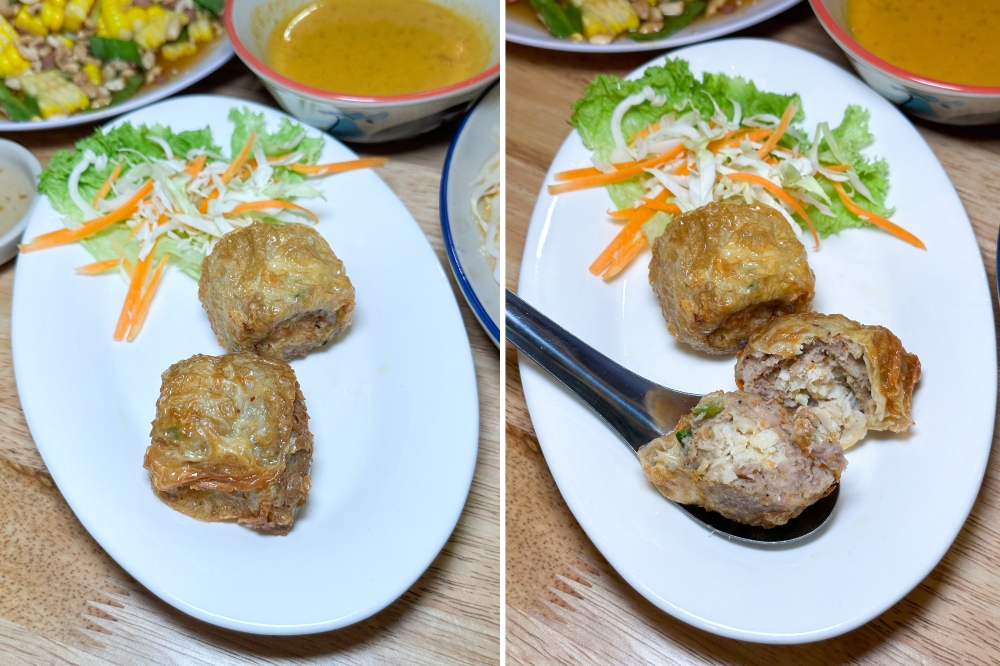
‘Hoi jor’ is a maxed up version of the old school Chinese crab balls (left). What makes this ‘hoi jor’ exceptionally good is that pocket of fresh crab meat hidden inside (right)
Sunshine yellow crunchy egg noodles top a bowl of smooth egg noodles with an orange hued curry rich with coconut milk. You will find a piece of chicken leg, perfectly cooked till the meat is juicy and easily tears apart from the bone. There’s also two tiny pork balls.
On the side, you’re given a wedge of lime, sliced onions and pickled mustard greens. Squeeze the lime and toss the garnishes inside your bowl. For a spicier kick, add a spoonful of Thai dried chilli powder from the condiments placed on the table.
Slurp down that combination of the crunchy noodles with the slippery noodles with that gentle curry with just a hint of spiciness. It may not be the most fragrant version but it fixed my cravings for khao soi without leaping on an aeroplane.
Level up your khao soi with their freshwater prawn version. Available at RM23 and subject to availability, your humble chicken is given a fairy godmother transformation to a huge specimen of freshwater prawn. There’s also a crispy chicken fillet version too for RM16.
Crab is featured in two dishes here.
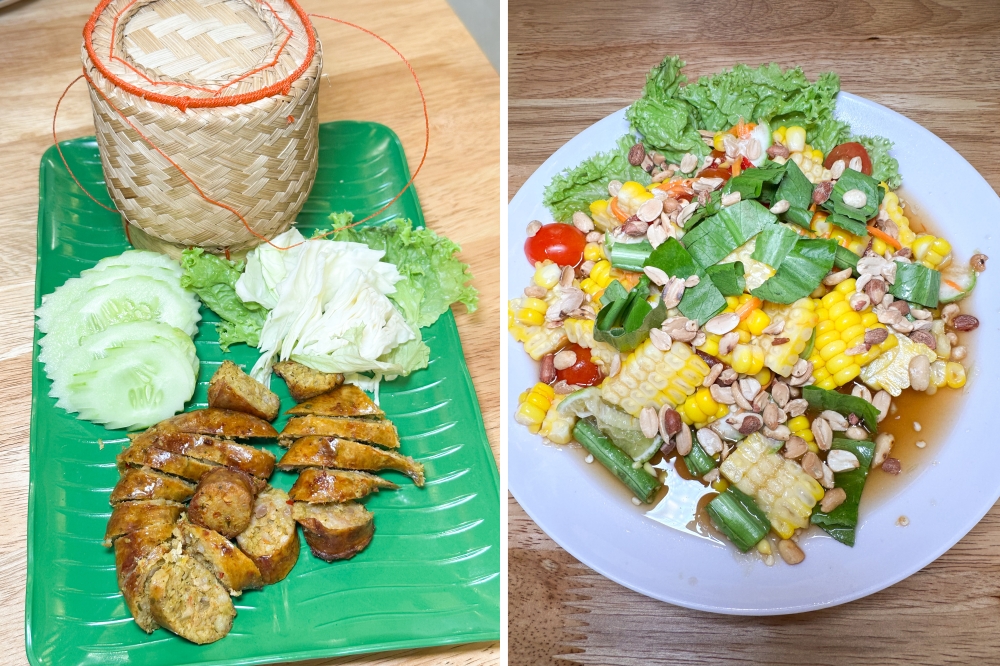
Premium Sai Ua is the iconic Chiang Mai pork sausages eaten with vegetables or sticky rice hidden in that tiny woven basket (left). Tam Khao Poad is good for those who like spicier flavours with their mixture of corn, tomatoes, baby eggplants and peanuts (right).
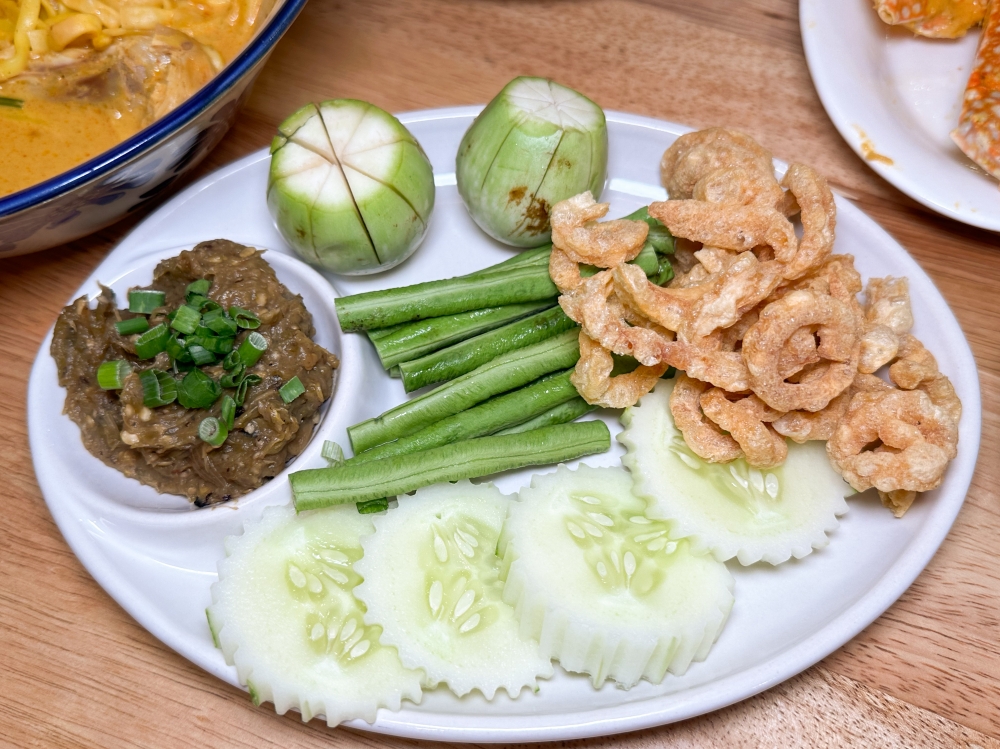
Nam Prik Noom with Khaep Moo was a good way to fix cravings for crispy pork cracklings but the toasted green chillies dip had a flat taste.
Khanom Jeen Nam Ya Pu (RM35) sees Thai laksa given a luxury makeover with half of a flower crab. Usually I would dismiss this as a way to just boost the price of a dish. I was proven wrong as the flower crab was probably the best I have tasted with its delicate, sweet flesh.
You’ll need to get your hands dirty to scrape every bit of the meat from the crab but it’s worth it. You do get some crabmeat on top of the laksa but nothing beats digging for it yourself. Spoon a little of the creamy curry with your smooth rice noodles and crabmeat to enjoy. There’s also pickled mustard greens, long beans, bean sprouts, Thai basil and fish balls to add to your laksa.
The crab theme continues with their Hoi Jor. In the same vein as those crab balls served in Chinese restaurants, this version is a little different. There’s a jumbo version, where two nuggets are priced at RM15. Or go for the regular sized one, where three pieces are RM12.
I’ve often wondered where the crab is in those crab balls at Chinese eateries, as all I taste is minced pork in their versions. Well, this Hoi Jor is chock full of crab meat wrapped in a blanket of minced pork. It’s encased in beancurd skin and deep fried. You dip it in sweet plum sauce but I prefer eating it on its own to relish the sweet crabmeat taste. It was so tasty my friend brought home another portion to share with her husband.
We went mad over the snacks since they were a wide selection of tasty bites. You have Moo Ping (grilled pork skewers), Thai fish cakes, BBQ pork balls and fried wantans.
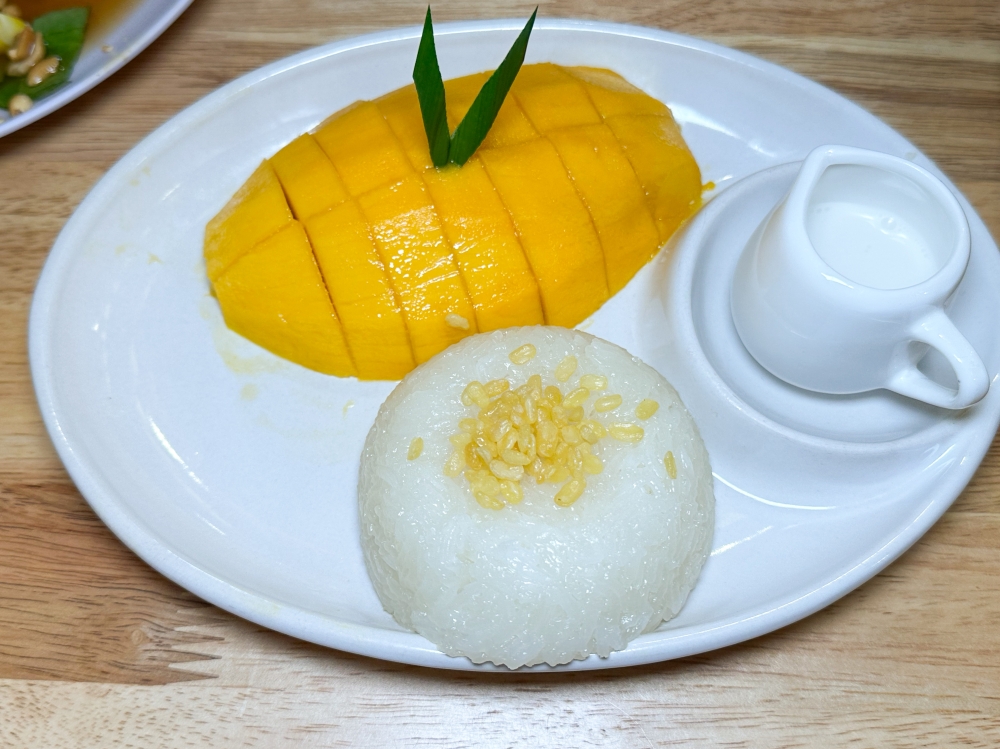
Mango Sticky Rice is the best way to end a meal and this version boasts sweet, just ripe mango with sticky rice and a touch of coconut milk.
Another Chiang Mai must-eat is sai ua or sausages packed with minced pork and a medley of aromatic herbs and spices. On the original menu, it’s not available but they added back the Premium Sai Ua in the additional menu. Select from two sizes, either 125 grams with sticky rice for RM22 or 250 grams with sticky rice for RM38.
The sausages are served slightly warm and sliced. You can eat it with a salad of raw vegetables. Or open the small woven basket and find a plastic bag filled with piping hot steamed sticky rice to eat the sausages with.
Spying on our neighbours, we saw them relishing pig skin crackers or khaep moo. We decided to try the Nam Prik Noom with Khaep Moo (RM12).
While the pig skin crackers were absolutely the best, the grilled green chillies dip didn’t live up to our expectations. Usually it needs to be pungent and spicy to complement the raw vegetables but this dip fell flat.
On the other spectrum, we instead found the heat in the Tam Khao Poad (RM15) or the corn salad. While we enjoyed the corn, cherry tomatoes and baby eggplants salad topped with peanuts, the salad dressing that was used was super spicy.
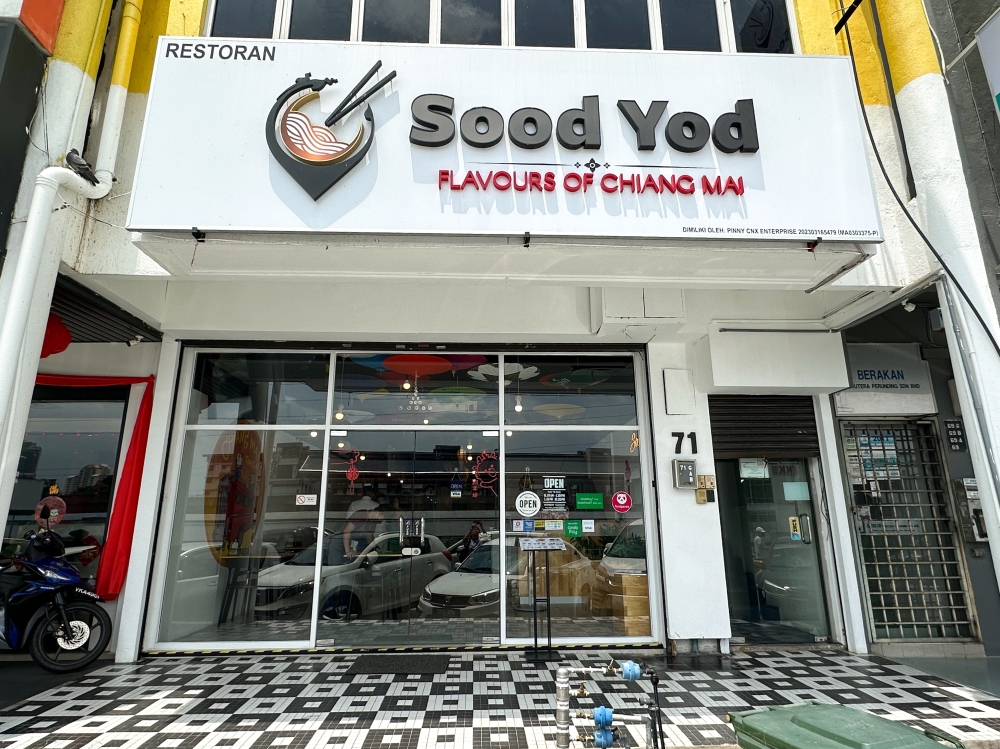
The Thai eatery is located at the row of shophouses that houses Pathlab, which is adjacent to the Damansara-Puchong Expressway (LDP) and right across the Kelana Jaya LRT station.
You also have various salads, like sour mango and papaya too. If you have done your research and seen the fruit salad in social media, that’s not on the menu anymore.
Desserts are a choice of only two items. One is the unusual grass jelly served with milk and caramel. The other is the ubiquitous Mango Sticky Rice (RM12).
It’s a dessert anchored on the ripeness of the mangoes. This one was perfect, with golden yellow ripe flesh that was sweet. Their version of sticky rice tends to be more lumpy than I like but it’s still good eaten warm with a little coconut milk with the sweet mango.
Occasionally there’s special seasonal items too at the counter. I managed to grab a bottle of Thai orange juice for RM8. It’s made from those green skinned oranges you find at roadside stalls. As these oranges aren’t acidic like the ones we usually get, this produces a bright orange juice that is incredibly sweet and fragrant. Drink it chilled to beat the heat.
Parking can be a nightmare during the weekdays. It’s relatively easier during the weekends. Alternatively, their food is also available on GrabFood and Food Panda, for easy convenience.
Sood Yod Thai, 71, Jalan SS25/2, Taman Bukit Emas, Petaling Jaya. (next to Sovotel Boutique Hotel) Open: 11.30am to 2.30pm, 5.30pm to 10.30pm. Closed on Monday. Tel:017-3955069. Instagram: @soodyodthai
*This is an independent review where the writer paid for the meal.
*Follow us on Instagram @eatdrinkmm for more food gems.


